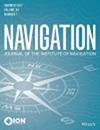Stochastic Reachability-Based GPS Spoofing Detection with Chimera Signal Enhancement
IF 2
3区 地球科学
Q1 ENGINEERING, AEROSPACE
引用次数: 0
Abstract
To provide secure navigation for civilian global positioning system (GPS) users, the Air Force Research Lab (AFRL) has developed the chips-message robust authentication (Chimera) (Anderson et al., 2017) signal enhancement for the GPS L1C signal (GPS Directorate, 2022). Chimera inserts a digital signature within both the navigation message and the pilot channels of L1C to allow civilian users to jointly authenticate both components of the signal (AFRL Space Vehicles Directorate, Advanced GPS Technology, 2019). The AFRL will broadcast and test this signal enhancement on the upcoming Navigation Technology Satellite 3 experimental platform, which will be launched in 2024 (Cozzens, 2021; Divis, 2019, AFRL, 2023). If incorporated within the GPS L1C signal, the Chimera enhancement will be the Abstract To protect civilian global positioning system (GPS) users from spoofing attacks, the U.S. Air Force Research Lab has proposed the chips-message robust authentication (Chimera) enhancement for the L1C signal. In particular, the Chimera fast channel allows users to authenticate the received GPS signal once every 1.5 or 6 s, depending on the out-of-band source utilized for receiving the fast channel marker keys. However, for many moving receiver applications, receivers often use much higher GPS measurement rates, at 5–20 Hz. In this work, we derive a stochastic reachability (SR)-based detector to perform continuous GPS signal verification and state estimation between Chimera authentications. Our SR detector validates the received GPS measurement against any self-contained sensor, such as an inertial measurement unit, in the presence of bounded biases in the sensor error distributions. We demonstrate via Monte Carlo simulations that our detector satisfies a user-defined false alarm requirement during nominal conditions, while successfully detecting a simulated spoofing attack. We further demonstrate that our SR state estimation filter successfully bounds the true state during both authentic and spoofed conditions.基于随机可达性的嵌合体信号增强GPS欺骗检测
本文章由计算机程序翻译,如有差异,请以英文原文为准。
求助全文
约1分钟内获得全文
求助全文
来源期刊

Navigation-Journal of the Institute of Navigation
ENGINEERING, AEROSPACE-REMOTE SENSING
CiteScore
5.60
自引率
13.60%
发文量
31
期刊介绍:
NAVIGATION is a quarterly journal published by The Institute of Navigation. The journal publishes original, peer-reviewed articles on all areas related to the science, engineering and art of Positioning, Navigation and Timing (PNT) covering land (including indoor use), sea, air and space applications. PNT technologies of interest encompass navigation satellite systems (both global and regional), inertial navigation, electro-optical systems including LiDAR and imaging sensors, and radio-frequency ranging and timing systems, including those using signals of opportunity from communication systems and other non-traditional PNT sources. Articles about PNT algorithms and methods, such as for error characterization and mitigation, integrity analysis, PNT signal processing and multi-sensor integration, are welcome. The journal also accepts articles on non-traditional applications of PNT systems, including remote sensing of the Earth’s surface or atmosphere, as well as selected historical and survey articles.
 求助内容:
求助内容: 应助结果提醒方式:
应助结果提醒方式:


